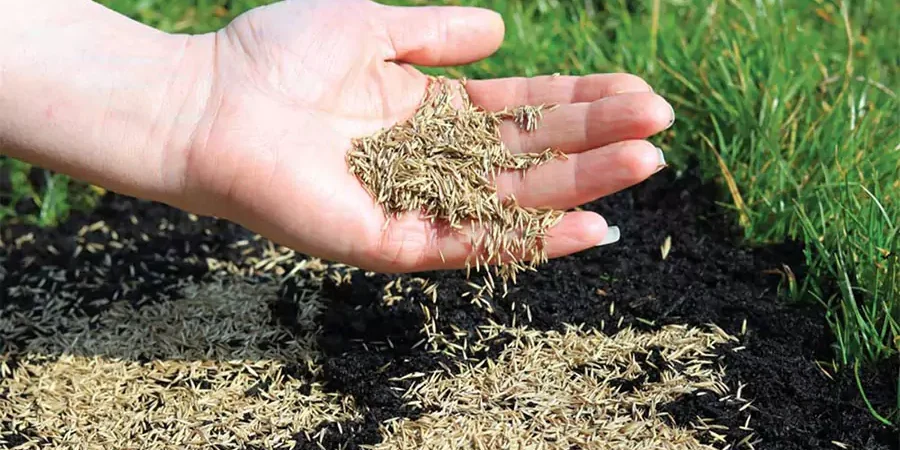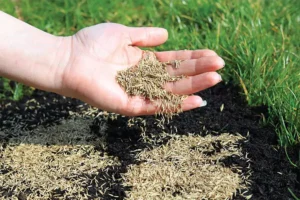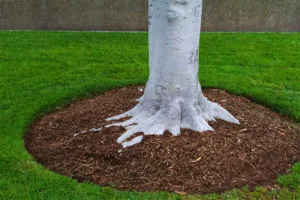A healthy lawn doesn’t just appear—it’s built through good timing, steady lawn care practices, and attention to local conditions. In Omaha, NE, the weather can be tricky, with hot summers, cold winters, and everything in between.
Overseeding is one of the best ways to keep your lawn looking its best, but if it’s delayed, root development can take a big hit. That means thinner turf, weeds pushing through, and more work later.
Let’s discuss how delayed overseeding affects lawns in the Omaha metro area, why timing matters, and how professional lawn maintenance contractors can give your turf the support it needs.
Why Does Timing Matter for Overseeding in Omaha?
What happens when overseeding is delayed?
Grass seed needs the right soil temperatures and moisture to sprout. If overseeding is delayed past the prime season, seeds struggle to take root before weather conditions shift.
- Spring and fall give the best results. Mild weather helps seeds germinate quickly and develop strong roots.
- Waiting too long creates stress. Late overseeding can leave seedlings weak and shallow-rooted, especially before winter hits.
- Local climate plays a role. Omaha lawns deal with both heat and freezing conditions, so missed timing means poor root establishment.
How Do Roots Develop After Overseeding?
Why are roots so important?
Roots are the anchor of any lawn. Without deep roots, grass won’t survive drought, pests, or heavy foot traffic.
- Healthy turf depends on strong roots. Deeper roots allow grass to access water and nutrients, keeping your lawn green even in summer heat.
- Overseeding helps fill bare spots. New seedlings add density to your Omaha lawn, giving weeds less room to spread.
- Root development protects against stress. Strong root systems hold soil in place and prepare lawns for snow removal season in Nebraska.
What Are the Risks of Overseeding Too Late?
In the Omaha area, timing matters a lot when it comes to overseeding. If you miss the right window, your lawn may struggle more than you expect. Late overseeding puts grass seed in tough conditions, making it harder for new growth to take root and stay strong.
That’s why it’s essential to plan with a comprehensive guide to year-round lawn care maintenance service in mind—so you’re not just reacting to problems but staying ahead of them with a seasonal strategy that supports healthy, resilient turf.
Risks of Late Overseeding:
Shallow roots
Seeds don’t have time to grow deep roots before cold weather sets in.
Thin grass coverage
Patchy spots stay bare, leaving your lawn uneven.
More weeds
Weeds take advantage of weak grass and fill in the empty spaces.
Poor germination
Cooler soil slows down seed sprouting or stops it completely.
Higher maintenance needs
You’ll spend more time and money on lawn care to fix the weak spots later.
How Do Aeration and Overseeding Work Together in Omaha Lawns?
Why pair aeration with overseeding?
Aeration and overseeding are a team effort. Aeration involves removing small plugs of soil, which reduces soil compaction and creates pockets for seed to settle.
Aeration improves soil conditions. Loosened soil allows water, air, and fertilizer to reach roots.
Overseeding fills in thin areas. Seeds fall into aeration holes, protecting them from wind and birds.
Together, they promote a healthier lawn. In the Omaha metro, pairing the two in spring or fall leads to a lawn that can handle heavy weather conditions year-round.
How Does Fertilization Help New Seedlings?
Do seedlings need extra food?
Yes. Fertilizer is like a starter meal for new grass. Without it, seedlings may sprout but won’t thrive.
Fertilization boosts growth. It gives seedlings the nutrients they need to build strong roots and a lush lawn.
Timing matters for fertilization. Applied too early, fertilizer can burn tender grass; applied right, it supports healthy turf.
Fertilizer plus overseeding equals success. Combined with weed control, fertilization helps Omaha lawns grow thick, green, and weed-free.
What Role Do Weather Conditions Play?
Weather in the Omaha area can make delayed overseeding even tougher. Cold snaps can halt seed growth before roots form, while late-summer heat stresses young turf.
And with snow removal season arriving quickly, grass without strong root depth struggles to handle snow, ice, and salt along sidewalks and driveways.
Tips for Lawn Maintenance Service
Keeping a healthy Omaha lawn doesn’t have to feel like a chore. A few smart steps can make your lawn look great year-round.
- Mow at the right height: Cutting grass too short stresses it out. Keep your mower blades sharp and aim for steady, even trims.
- Water deeply, not often: A good soak encourages deep roots, while frequent shallow watering leaves grass weak.
- Aeration helps breathe life into soil: Opening up compacted soil lets water, air, and nutrients reach the roots.
- Fertilization keeps grass fed: The right fertilizer boosts growth and color, especially after overseeding.
- Keep up with weed control: Weeds compete for space, sunlight, and nutrients, so staying on top of them keeps your lawn looking full.
- Plan for weather in the Omaha area: Hot summers, cold winters, and snow removal mean timing your lawn care matters.
My lawn in Omaha really started to decline, and I couldn’t figure out why. I was mowing regularly and watering a few times a week, but the grass looked patchy, thin, and pale. I didn’t realize that cutting it too short and watering it too frequently were actually stressing it out.
The soil had become so compacted that nutrients and water weren’t even reaching the roots. That’s when I reached out to ShurLawn & Landscape. They came out, explained the importance of aeration and deep, infrequent watering, and put together a seasonal care plan customized for Omaha’s weather patterns.
After aerating and overseeding, they followed up with the right fertilization schedule and gave me clear mowing guidelines. Within a few weeks, I noticed stronger growth and a deeper green color.
Now, even with the hot summers and unpredictable weather, my lawn stays thick and healthy because I finally understand how everything from mowing height to weed control plays a role. Honestly, their help saved me from making more costly mistakes.
— Angela, Harrison Street
Frequently Asked Questions About Overseeding and Root Development in Omaha, NE
1. When is the best time to overseed in Omaha, NE?
The best time is early fall or spring. These seasons give seeds the right soil temperature and time to build strong roots before weather shifts.
2. Can I overseed in late fall?
You can, but the results are weak. Seeds may not germinate before frost, leaving you with poor root growth and bare spots in spring.
3. How does aeration help overseeding?
Aeration removes small plugs of soil, reducing compaction and creating space for seeds to settle. This makes it easier for roots to grow deep and strong.
Conclusion
Delayed overseeding can have a big impact on Omaha lawns. Without enough time for root development, turf becomes thin, weeds spread, and the lawn struggles under changing weather conditions.
By pairing aeration, overseeding, fertilization, and weed control at the right time, you can keep your lawn healthy, strong, and looking its best. If your Omaha lawn needs professional care, trust ShurLawn & Landscape.
As a family-owned lawn care business serving residential and commercial clients in the Omaha metro area, they offer aeration, overseeding, fertilization, mowing services, landscape design, snow removal services, and more.
Learn how one Omaha yard recovered after major storm damage and see how proper maintenance strategies can restore even the most affected lawns. For more information, call us today at 402-572-0710!




